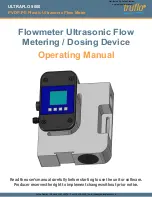
Section 12
Storage
YSI 556 MPS
YSI Incorporated
Page 100
dissolved oxygen sensor, with membrane cap still on, in the
probe module.
3.
Place 1/2
″
of water, deionized, distilled or tap, in the
transport/calibration cup.
CAUTION:
The water level has to be low enough so that none
of the sensors are actually under water. Check the
transport/calibration cup periodically to make certain that the
water is still present or the sponge is still moist.
4.
Insert the probe module into the cup.
NOTE:
Ensure that an o-ring is installed in the o-ring groove
on the threaded end of the probe module body. See Figure 3.7
Transport/Calibration Cup Installation.
12.2.2
Sensor Storage
Temperature/Conductivity Sensor
No special precautions are required. Sensor can be stored dry or wet, as long
as solutions in contact with the thermistor and conductivity electrodes are
not corrosive (for example, chlorine bleach). However, it is recommended
that the sensor be cleaned with the provided brush prior to long term
storage. Refer to Section
11.1.4 Temperature/Conductivity Sensor Cleaning.
pH and Combination pH/ORP Sensor
The key to sensor storage is to make certain that the reference electrode
junction does not dry out. Junctions which have been allowed to dry out due
to improper storage procedures can usually be rehydrated by soaking the
sensor for several hours (overnight is recommended) in a solution which is 2
molar in potassium chloride. If potassium chloride solution is not available,
soaking the sensor in tap water or commercial pH buffers may restore sensor
function. However in some cases the sensor may have been irreparably
damaged by the dehydration and will require replacement.
CAUTION:
Do not store the sensor in distilled or deionized water as the
glass sensor may be damaged by exposure to this medium.
1.
Remove the pH or pH/ORP sensor from the probe module.
Summary of Contents for YSI 556 MPS
Page 1: ...YSI Environmental YSI 556 MPS Multi Probe System Operations Manual ...
Page 2: ......
Page 6: ......
















































